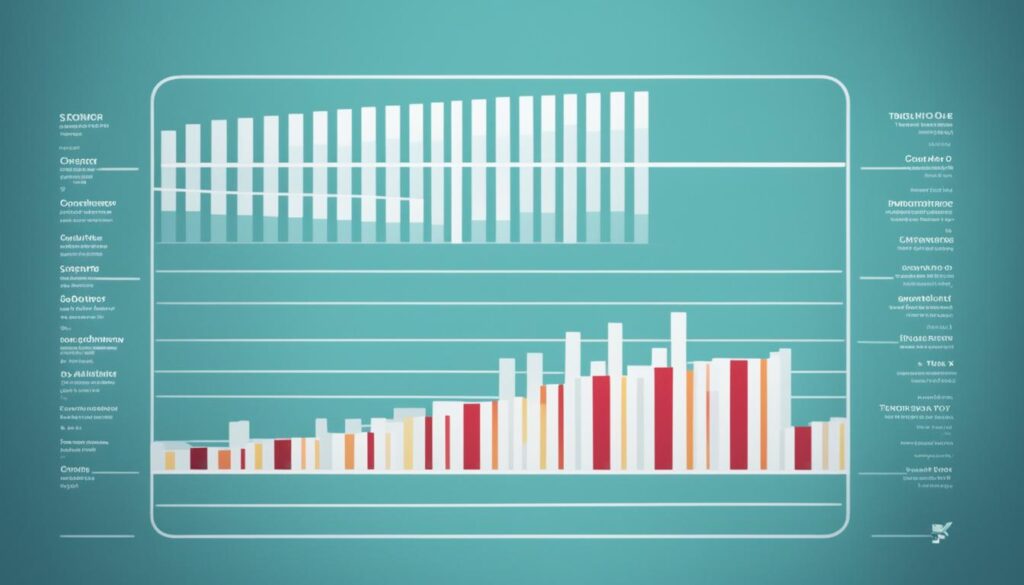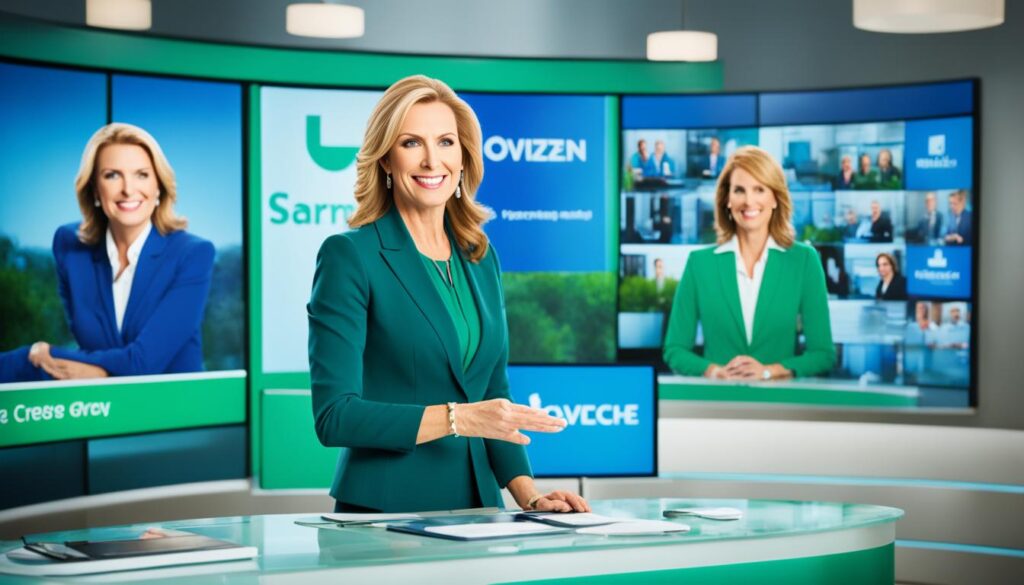
Have you ever thought about what makes a TV spokesperson stand out? Why do some capture attention and gain trust while others don’t? It’s all about possessing 10 key qualities that can attract and keep viewers’ trust.
Key Takeaways:
- Clear communication and relatable storytelling are key to engaging audiences.
- Authenticity and credibility are crucial in building trust with viewers.
- Understanding the target audience and tailoring the message accordingly is essential.
- Confidence and charisma help spokespersons establish a strong on-screen presence.
- Being adaptable and quick-thinking enables spokespersons to handle live interviews and unexpected situations.
Define Your Goals
Before measuring a spokesperson’s success, you need clear and measurable goals. These will guide their work with the audience. Here are important points to consider:
1. Raise Awareness
A key goal for a spokesperson is to spread the word about an organization or cause. By crafting and delivering messages well, they grab attention and make a mark.
2. Educate
Spokespersons also need to educate people on important issues. They help by giving valuable information and simplifying complex ideas, becoming a go-to source.
3. Persuade
A good spokesperson can persuade and move the audience. Whether it’s for promoting a product or supporting a cause, they make people want to act or think differently.
4. Inspire
They should also inspire the audience with stories and experiences. This motivation can drive others to reach their goals or positively change their community.
Setting SMART goals helps measure a spokesperson’s success. These goals keep efforts clear and focused, choosing the right ways to track progress.
An effective spokesperson connects emotionally with people. They deliver messages in ways that stick, getting the audience to react as hoped.
Track Your Outputs
Measuring a spokesperson’s success is possible by tracking their public relations outputs. Keeping an eye on media coverage, social media mentions, and engagement helps. These measures offer a clear view of a spokesperson’s impact.
Looking at media coverage is essential. It shows how visible the spokesperson is. This includes checking articles and news they’re in and the tone of those pieces. If the coverage is good, it shows they’re communicating well.
Don’t forget about social media. Tracking a spokesperson on Twitter, Facebook, and Instagram shows if their messages hit the mark. The number of mentions, likes, and comments reveals their social media power.
“Social media has become an integral part of public relations, allowing spokespersons to directly engage with their audience and build relationships. Tracking their interactions and measuring the impact of their posts is crucial to understanding their effectiveness.”
To track these measures, use media monitoring services and social media tools. These help in collecting and analyzing data for better reports. With accurate data, evaluating a spokesperson’s success is much easier.

Continue reading to learn how measuring the outcomes of a spokesperson’s activities can provide further insights into their effectiveness.
Measure Your Outcomes
Evaluating a spokesperson’s success means looking at the impact of their PR activities. It’s about seeing how they’ve changed awareness, knowledge, and attitudes in their audience. By studying these changes, we learn how effective the spokesperson has been.
There are many ways to measure these outcomes, like with polls or interviews. These methods help understand the influence of the spokesperson’s work. Getting direct feedback from those targeted reveals if the strategies worked as intended.
“Effective measurement of outcomes helps organizations understand the true impact of their spokesperson on audience awareness, attitudes, and behaviors.”
Using surveys, we can see how much the audience’s awareness has grown. Interviews and focus groups show us their real thoughts and feelings. By observing and analyzing data, we spot changes in behavior clearly.
Understanding these outcomes helps organizations see the value their spokesperson added. By looking at the results, they can adjust their plans. This way, they aim to better reach their goals and engage their audience.
Benefits of Measuring Outcomes
There are key advantages to assessing spokesperson outcomes:
- It shows how well the spokesperson has shifted audience mindsets and actions.
- It tracks how much the audience has learned from the spokesperson.
- It checks if the spokesperson’s efforts met the organization’s goals.
- It uncovers ways to make the spokesperson’s approach even better.
Measuring these outcomes is vital for continuous improvement. It helps organizations refine their communication tactics. This ensures they connect more effectively with their audience.

Understanding a spokesperson’s impact is crucial. It involves looking at changes in how the audience thinks, feels, and acts. This insight helps tweak and improve strategies. It makes the spokesperson’s work more impactful over time.
Compare Your Benchmarks
It’s crucial to measure how well a spokesperson does by comparing their results with others in the industry. This comparison helps you understand their performance and see where they can do better. You might look at their past performance, what competitors are doing, industry norms, or the best practices out there.
Tools like a SWOT analysis, competitor analysis, or gap analysis help gather and look into these benchmarks. By looking at how the spokesperson stacks up against these standards, you learn about their strong points and weak spots. You also find chances for them to grow.
Evaluate the spokesperson’s media coverage, social media responses, and how wide an audience they reach. Then, compare these aspects with the average or with what competitors are achieving. This comparison gives a clear view of the spokesperson’s effectiveness in the field.
Setting benchmarks against industry norms and competitors helps aim for better performance. This approach, based on real data, helps make smart decisions. It’s about improving how the spokesperson appears to the public.
Benefits of Benchmarking
Comparing your spokesperson’s results with others offers several advantages. You can:
- Find areas to get better
- Set realistic goals for performance
- Boost media presence and online engagement
- Be one step ahead of competitors
- Make your spokesperson more effective
Benchmarking brings valuable insights. It helps improve your spokesperson’s performance with data-backed choices. By always aiming higher and surpassing industry standards, you build trust, engage more people, and score amazing outcomes.

Solicit Feedback
Getting feedback is key to knowing if a spokesperson is doing well. If you ask for feedback, you learn what people think and want. This helps understand their satisfaction and loyalty. Feedback makes a clear path for talking directly with the audience. It helps you know what they need.
There are many ways to collect feedback. Through online reviews, testimonials, and ratings, people can express their thoughts. By keeping an eye on these, you gather deep insights into what everyone thinks.
Both internal and external feedback matter a lot. Feedback from your team shows how the spokesperson looks inside the organization. Feedback from outside, like from customers, gives a wider view on their effectiveness.
When asking for feedback, it’s vital to make people feel safe to speak their truth. Let them share thoughts openly or anonymously. This way, you get real feedback. Also, always say thank you for the feedback. It shows you value their views.
Benefits of Soliciting Feedback:
- Gaining insights into stakeholder perceptions
- Understanding expectations and satisfaction levels
- Building loyalty and trust with stakeholders
- Identifying areas for improvement
“Feedback is a valuable asset in shaping the effectiveness of a spokesperson. It provides a direct line of communication and allows for continuous improvement in engaging stakeholders.”
To make a spokesperson better, always ask for feedback. Then, act on it. This makes your bond with stakeholders stronger and deeper.

Improve Your Practices
Just measuring how effective you are isn’t enough. It’s key to act on what the data tells you. By enhancing spokesperson skills, their performance, and reputation, PR results get better.
One smart move is creating action plans for betterment. These plans should aim for SMART goals – those that are Specific, Measurable, Achievable, Relevant, and Time-bound. Setting clear goals helps spokespersons focus on key areas for growth.
The PDCA cycle, standing for Plan, Do, Check, Act, is also a great tool. It’s often used in improving quality. This process lets spokespersons find weak spots, make changes, see the results, and adjust again. It’s a cycle for continuous refinement.
To boost spokesperson skills, investing in professional growth is essential. Media training workshops and public speaking courses are great. They sharpen communication skills, enhance storytelling, and boost message delivery confidence.
Teamwork is also crucial for growth. Working with colleagues and getting feedback helps. It allows for the sharing of insights and learning from each other. This way, everyone improves together.
In the end, aiming for constant betterment can enhance spokesperson abilities. This leads to more effectiveness and better PR outcomes. With a mindset for growth and seeking development opportunities, spokespersons can consistently make a big impact.

Know Your Media Contacts
Building good media relations means really knowing who you’re reaching out to. This includes journalists, bloggers, podcasters, and influencers. By understanding them, you can make your pitches perfect, build a good connection, and boost your chances of getting noticed. Let’s dive into some key steps to make your media relations better.
- Research Media Contacts: Spend time learning about your media contacts. Know what topics they like, who their audience is, and what kind of content they prefer.
- Engage on Social Media: Follow them on Twitter, LinkedIn, and Instagram. Take time to read or listen to their work. Show you care by liking, commenting, and sharing their posts. It shows you respect their work and are genuinely interested.
- Tailor Pitches: Make your pitches match the specific needs of each media contact. Look at their recent work to see what they focus on. This way, your pitch will be more relevant and interesting to them.
- Respect Deadlines: Media professionals have strict schedules. Respect their time by meeting deadlines and answering their requests quickly. Being dependable and quick to respond helps build trust.
To create lasting media relationships, follow these steps. Be respectful, offer valuable content, and always be professional and reliable. These are key to strong, lasting media connections.
Research Media Contacts Example:
Imagine you’re releasing a new tech product and want tech journalists to talk about it. Instead of generic emails to many people, you research each journalist for a tailored approach:
“John Doe recently wrote about new wearable tech. He loves health tech and has lots of followers on his blog. Knowing this, I’ll show him how our product changes fitness tracking and health.”
Respect Deadlines Example:
A well-known tech journalist is interested in your product. They ask for more details and samples by a certain date:
“Dear [Journalist’s Name],
Thanks for your interest in our tech product. I’m glad to send more info and samples.
I’ll make sure everything gets to you by [deadline]. Feel free to ask if you need more help or have questions.
Thanks for thinking of our product. I can’t wait to see what you think.
Best Regards,
[Your Name]”
By knowing their interests, respecting their time, and providing clear info, you become a trusted and helpful source for your media contacts.
Be Transparent and Ethical
Building trust and credibility in media relations requires **honesty in media relations**, **transparency**, and **media ethics**. Keeping a high level of integrity and following ethical practices with media is key.
Being honest is fundamental when dealing with media. Avoid lying, exaggerating, or misleading. Truthfulness and authenticity are crucial for trust and credibility.
It’s important to be open about **negative news or issues**. Hiding bad news can harm your reputation. Approach problems directly, with correct and quick information.
Don’t offer **bribery** or **quid pro quos**. These actions are wrong and harm media relationships. Build connections on respect and shared aims instead.
Be clear about your goals and what you expect with media contacts. Set boundaries and be transparent about your intentions. This helps make sure everyone understands each other.
Admitting mistakes is key in ethical media relations. Own up and fix errors quickly. This shows you’re responsible and committed to high journalistic standards.
Following **journalism** and **media ethics** rules is vital. Get to know the ethical guidelines by groups like the Society of Professional Journalists or the Public Relations Society of America.
By being honest, transparent, and ethical, you can create lasting, trust-based relationships.

Build Relationships and Rapport
Treating media contacts as partners is crucial, not just as tools. A strong rapport can help your PR efforts. It’s important to show true interest in their work and achievements. Congratulate them on awards, promotions, or milestones.
Sending thank-you notes or small tokens of appreciation helps. These actions show you value their hard work. They’ll remember your kindness in future projects. Building relationships is about personal connection, not just work.
“Building strong relationships with media contacts is the foundation of successful PR campaigns. Showing appreciation for their hard work can make all the difference in maintaining a positive and productive partnership.”
Engaging With Media Contacts
Interacting with media contacts on social media strengthens relationships. Like, share, and comment on their posts when it’s right. This shows you’re engaged with their content.
Meeting media contacts in person at events can build stronger bonds. Attend industry events, conferences, or seminars. Networking in person leads to more meaningful connections.
Invite media contacts to exclusive events for your organization or industry. Giving them special access shows you value their insights. It lets them find unique content for their audience.

Building strong relationships with media contacts is key to PR success. Treat them as partners and show appreciation, whether online or in person. These steps are vital for creating lasting and beneficial connections.
Provide Value and Expertise
When you talk to media people, show them what you know and the value you bring. Show how you can help them by solving issues, answering questions, or pleasing their audience. Share your knowledge, tips, trends, and the best ways to do things related to their interest areas. This will make your pitch stand out.
Giving media exclusive access, early previews, or important news can make their stories better. By offering them unique and valuable info, you become a leader in your field. This proves you’re credible and an expert, which builds your reputation with media and their audience.
Sharing Valuable Insights
Adding value in media relations includes sharing insights that media find useful. You could highlight new trends, provide data, or give expert opinions. Your insights keep media up to date and help them deliver quality content. By being a reliable info source, you help both sides.
Offering valuable insights helps media contacts create engaging and informative content for their audience while establishing your authority as a trusted expert in your field.
Exclusive Access and Previews
Giving media exclusive access and previews can make their stories stand out. This could be sneak peeks at new products, behind-the-scenes looks, or early industry reports. By giving them exclusive content, you build a partnership that strengthens your relationship with them.
Positioning Yourself as a Thought Leader
Being a thought leader helps you get noticed by the media as an industry expert. Share your expertise in articles, blog posts, or whitepapers. This makes you a key resource for topics and insights in your field. It not only gives media great content but also builds trust, making them want to work with you.
Remember, when interacting with media, it’s key to offer value, share your knowledge, and give exclusive access. This approach builds strong, beneficial relationships with your media partners.
| Benefits of Providing Value and Expertise |
|---|
| Increase media coverage and exposure |
| Establish credibility and authority in your industry |
| Build stronger relationships with media contacts |
| Generate more organic and positive media mentions |
| Enhance brand reputation and visibility |

Conclusion
Effective TV spokespersons are key in public relations. They grab attention and build trust with their audience. To improve, they need to set goals, track progress, and get feedback.
Having good relationships with the media is essential. Being honest and skilled plays a big part in success. TV spokespersons hold the power to grab and keep viewer attention.
The art of being a TV spokesperson involves many skills. They connect emotionally and share memorable messages. Their power lies in truthful, engaging communication.